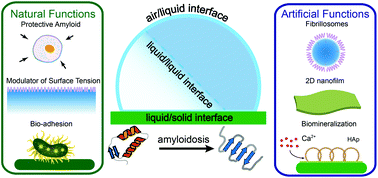Functional amyloid materials at surfaces/interfaces
Abstract
With the development of nanotechnology, functional amyloid materials are drawing increasing attention, and numerous remarkable applications are emerging. Amyloids, defined as a class of supramolecular assemblies of misfolded proteins or peptides into β-sheet fibrils, have evolved in many new respects and offer abundant chemical/biological functions. These proteinaceous micro/nano-structures provide excellent biocompatibility, rich phase behaviours, strong mechanical properties, and stability at interfaces not only in nature but also in functional materials, displaying versatile interactions with surfaces/interfaces that have been widely adopted in bioadhesion, synthetic biology, and composites. Overall, functional amyloids at surfaces/interfaces have excellent potential applications in next-generation biotechnology and biomaterials.



 Please wait while we load your content...
Please wait while we load your content...